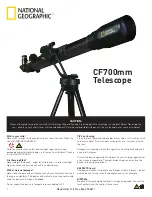
N
O
R
TH
ERN
H
E
M
ISP
H
ERE
P
O
LAR
A
LIGN
M
EN
T
1. To align your telescope in the
N
orthern Hemisphere, first find the
location of Polaris in the night sky.
Y
ou can easily find polaris by using
the Big Dipper to “point” at Polaris.
The two stars which make up the
edge of the dipper in the Big Dip-
per will roughly “point” at Polaris.
Y
ou can also use the star at the end
of the handle of the Big Dipper and
the star on the edge of the shal-
lower end of Cassiopeia to draw a
line through Polaris. The illustration
shows this.
2. Loosen the declination axis by turning the declination release lever. Turn
the optical tube assembly so that the arrow on the declination scale points at
0 . Once the arrow points at 0 , the optical tube assembly will be pointed 90
from the polar axis and you will be able to use the polar alignment scope.
3. Remove the lenscaps on the polar alignment scope. The objective of the
polar alignment scope should be directly above the north leg of the tripod
(labelled with an
N
). Turn the telescope, tripod and all, so that the front of
the mount faces north.
Y
ou can use a compass to find magnetic north and
then line up with Polaris (celestial north) or line up the front of the tele-
scope in line with Polaris by imagining a straight line running from Polaris
down to the horizon.
4
. Loosen the latitude adjustment screws. As you loosen the screws, you will
notice the number on the latitude scale change. Adjust the latitude scale until
Polaris is in the center of the polar alignment scope. Check that Polaris is
in the center of the telescope’s field of view by swinging the telescope tube
to 90 on the Dec. axis and looking through the focused eyepiece of the
telescope. The number on the latitude scale should match the latitude of your
viewing location. If there is a difference between the latitude of your viewing
location and the number shown on the latitude scale, check to make sure that
Содержание Kepler
Страница 1: ...KEPLER 152...





































